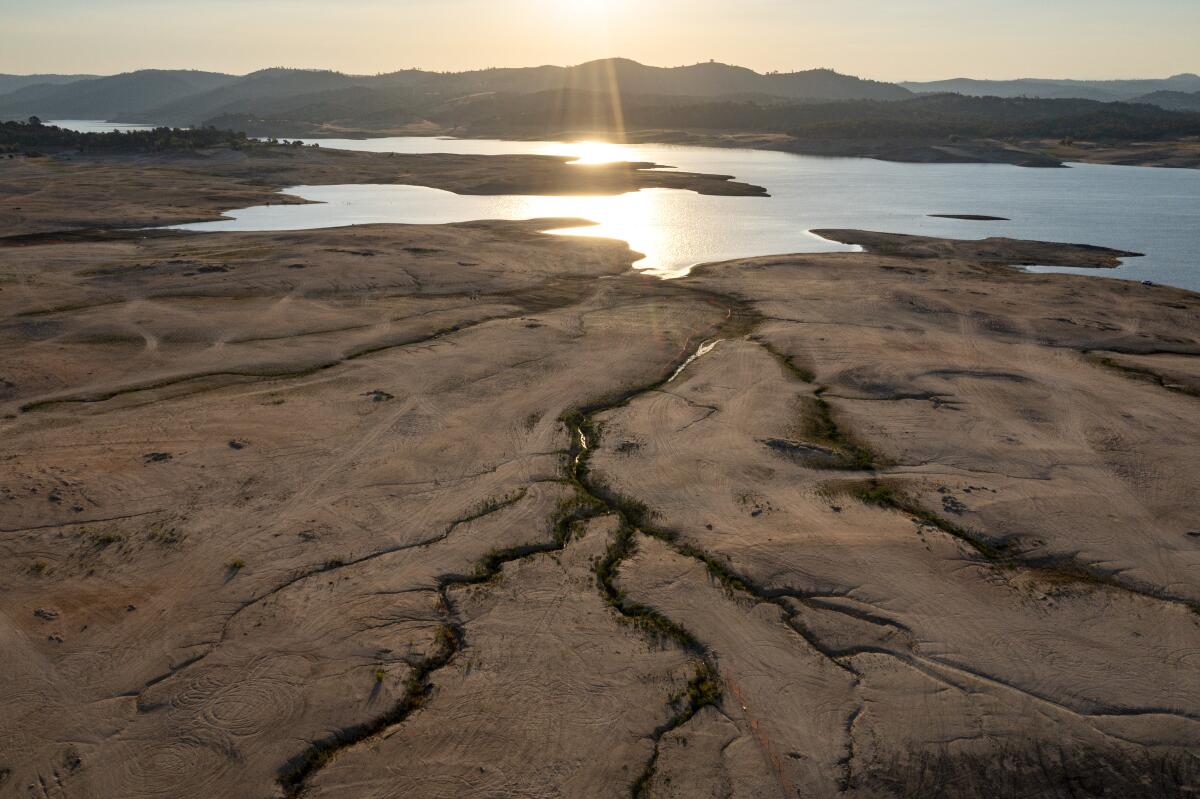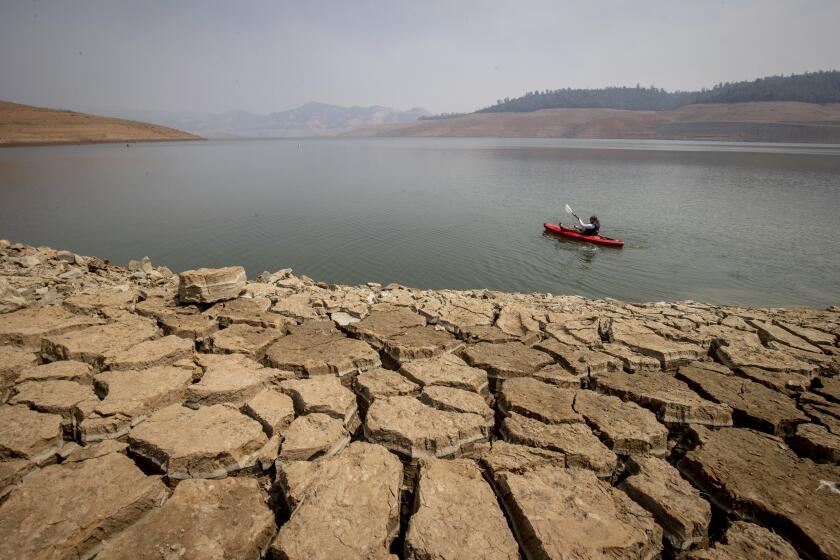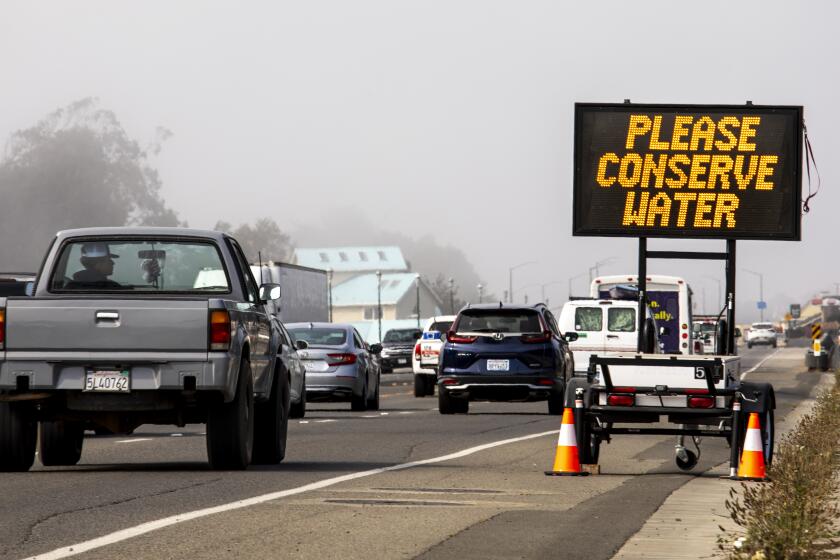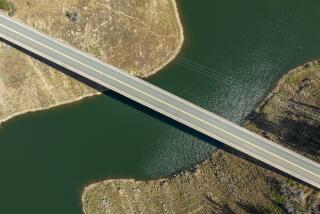Newsom calls for more aggressive water conservation amid third year of drought

- Share via
On the heels of the driest ever start to the year in California, Gov. Gavin Newsom on Monday issued a sweeping executive order calling on local water suppliers to implement more aggressive conservation measures as reservoirs dwindle and residents backslide in their efforts to cut back.
Specifically, the order requires that urban water suppliers activate “Level 2” of their locally customized contingency plans, meaning they must prepare for a shortage of up to 20%. The order also introduces steps to address a frenzy of well drilling in California’s Central Valley and directs state regulators to consider a ban on watering decorative grasses at businesses and public properties, among other measures.
“Everything that we can do to save water now will help us later in the year,” said Jared Blumenfeld, California’s secretary for environmental protection. “Within the context of climate change, water scarcity has become the new normal. Water scarcity — and how we treat this precious resource — has to be baked into everything that we do.”
The announcement came even as a much-needed rainstorm made its landing in Southern California, providing some relief but falling far short of a drought-busting March miracle. The latest U.S. Drought Monitor update, issued Thursday, showed nearly all of California under severe or extreme drought conditions.
After a record-dry start to 2022, California water officials have slashed State Water Project allocations from 15% to 5%.
Local water shortage contingency plans are designed to account for up to six levels of action, depending on the severity of water shortage suppliers are experiencing, officials said. At Level 2, local suppliers can reduce the number of days that residents can water outdoors, among other things. Level 3 would be triggered by a 20% to 30% shortage and require stronger actions.
“While we have made historic investments to protect our communities, economy and ecosystems from the worsening drought across the West, it is clear we need to do more,” Newsom said in a statement.
The announcement arrived amid mounting calls for mandatory statewide cuts — something Newsom’s predecessor, Jerry Brown, did in the last drought. Water experts in recent weeks have said mandatory cuts were overdue, and The Times’ editorial board last week opined that the governor’s pleas for voluntary reductions were not working.
Blumenfeld said the contingency plan was an improvement on the previous blanket approach because it accounts for local needs and capabilities. Of nearly 380 urban retail water suppliers in the state, 55 are at level zero, meaning they haven’t taken any action at all, and 171 are at Level 1, he said.
“What we learned from the last drought is that it’s really important to listen to locals — that we live in a state that has many different hydrological zones, many different water usage scenarios, and that the ‘one size fits all’ doesn’t really work in California,” he said.
Should conditions continue to worsen, “there could be an action to move to Level 3, rather than moving wholesale to a completely across-the-board number,” Blumenfeld said.
The drought is getting worse, and Californians are ignoring pleas to reduce water use voluntarily. It’s time for Gov. Gavin Newsom to order cuts.
Yet the path to Monday’s announcement has already been marked by several grim milestones — including regulators’ decision this month to slash State Water Project allocations from 15% to 5% because of dwindling supplies. As of Monday, statewide snowpack was 39% of average for the date. The water level in Lake Shasta — California’s largest reservoir — was 49% of average.
Some experts however, say Newsom’s order doesn’t go far enough.
“Is Tier 2 enough for the significant, historic drought we’re facing now?” asked Tracy Quinn, an engineer with the Natural Resources Defense Council. “Will that receive the amount of conservation that we need to get us through this year and what could be another dry year, or several dry years, to come?”
Some agencies, including the Los Angeles Department of Water and Power, have kept conservation plans in place since at least the previous drought, Quinn said, so she worried that Newsom’s plan could allow for more business as usual.
And though the agricultural sector continues to use the vast majority of California’s water, officials said the executive order does not include that sector in its scope — although they noted the number of acres fallowed is expected increase this year due to reduced agricultural water allocations.
Meanwhile, urban residents are still struggling in their efforts to save, and in fact have reached less than half of Newsom’s voluntary 15% target, according to recent data.
Rebecca Kimitch, a spokeswoman for the Metropolitan Water District of Southern California, said that if certain Southern California communities don’t reduce water use soon, there is “a real possibility then that the only water available would be health and human safety water, which means no water use outside at all.” Kimitch said this concern applies only to communities that are dependent on the State Water Project for their water, or communities that have limited or no local supplies and that cannot receive Colorado River water. This includes parts of Los Angeles, Ventura and San Bernardino counties.
But the executive order isn’t only about conservation: It also includes several key provisions to respond to and plan for worsening dryness. Among them are critical safeguards for groundwater supplies, such as prohibiting the drilling of new wells if they interfere with existing wells nearby, or are likely to cause land subsidence that would damage nearby infrastructure.
The order also prohibits local governments from granting well-drilling permits if the proposed well is “inconsistent” with any groundwater management program established under the Sustainable Groundwater Management Act, or SGMA.
Groundwater from aquifers accounts for about one-third of the state’s water supply during non-drought years, but makes up more than two-thirds of the state’s supply during drought years, Natural Resources Secretary Wade Crowfoot said, so “it’s really important as this drought persists that we’re protecting this important source of water.”
California passed its landmark groundwater law in 2014. The goals of sustainable management remain a long way off.
Also included in the order was a call for the State Water Resources Control Board to ban the irrigation of “non-functional” or decorative turf and grass adjacent to large industrial and commercial buildings. The ban would not include residential lawns or grass used for recreation, such as school fields and parks.
According to the governor’s office, that ban alone could result in potential water savings of several hundred thousand acre-feet. (An acre-foot of water serves the needs of approximately three households for a year.) But Amir Haghverdi, a professor of water management and environmental sciences at UC Riverside, said such reductions could come with significant trade-offs, such as sacrificing the cooling effect that such grass and plants may offer to communities.
Rather than a total shutoff, Haghverdi said he hoped the state could turn to more long-term solutions such as better auditing of irrigation systems to identify where water is being wasted.
“I am pro-water conservation, but we need to understand what’s going to happen if we’re promoting water conservation,” he said.
Others applauded the move.
“It is time for us all to recognize that, with our water supplies so stressed by drought and climate change, we should no longer be using precious water to nourish grass that no one plays on, no one walks on and only serves ornamental purposes,” Adel Hagekhalil, general manager of the Metropolitan Water District of Southern California, said in a statement.
Among other actions, Newsom’s order also streamlines permitting for groundwater recharge projects, “cuts red tape” for communities that need access to emergency hauled or bottled water, and helps expedite approvals for actions to protect fish and wildlife, including threatened salmon.
Officials said the myriad measures were necessary to prepare for what the rest of the year is likely to have in store. Though January, February and March are typically the heart of the state’s wet season, the months have been historically dry in 2022.
And despite Monday’s rain, climate outlooks point toward below-average precipitation across much of the state in the days and weeks to come.
More to Read
Sign up for Essential California
The most important California stories and recommendations in your inbox every morning.
You may occasionally receive promotional content from the Los Angeles Times.















